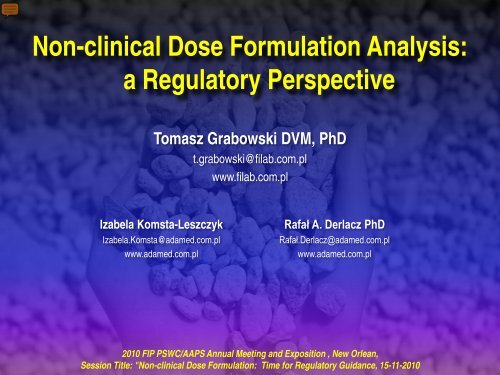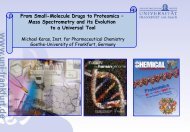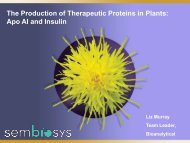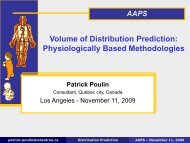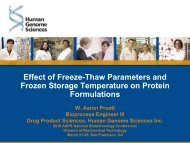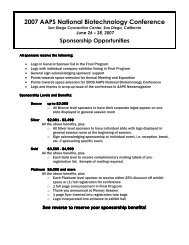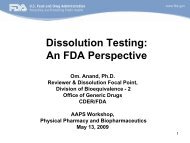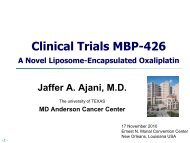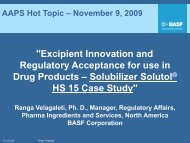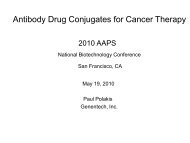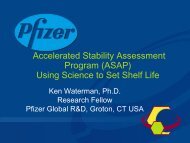Non-clinical Dose Formulation Analysis
Non-clinical Dose Formulation Analysis
Non-clinical Dose Formulation Analysis
Create successful ePaper yourself
Turn your PDF publications into a flip-book with our unique Google optimized e-Paper software.
<strong>Non</strong>-<strong>clinical</strong> <strong>Dose</strong> <strong>Formulation</strong> <strong>Analysis</strong>:a Regulatory PerspectiveTomasz Grabowski DVM, PhDt.grabowski@filab.com.plwww.filab.com.plIzabela Komsta-LeszczykIzabela.Komsta@adamed.com.plwww.adamed.com.plRafał A. Derlacz PhDRafał.Derlacz@adamed.com.plwww.adamed.com.pl2010 FIP PSWC/AAPS Annual Meeting and Exposition , New Orlean,Session Title: "<strong>Non</strong>-<strong>clinical</strong> <strong>Dose</strong> <strong>Formulation</strong>: Time for Regulatory Guidance, 15-11-2010
Regulatory documents and non-<strong>clinical</strong>and final formulation definitionsDevelopment pharmaceutics for veterinary medicinal products, EMEA 2000Development pharmaceutics, EMEA 1998Q2B Validation of Analytical Procedures: Methodology, ICH 1996Guidance for Industry Analytical Procedures and Methods Validation, FDA 2000NON-CLINICAL formulationFINAL formulation- lack of definition- lack of definitionGuideline On Validation Of Bioanalytical Methods, EMEA 2009Guidance for Industry Bioanalytical Method Validation, FDA 2001NON-CLINICAL formulation analysisFINAL formulation analysis- not applicable- not applicablewww.filab.com.pl
Pre<strong>clinical</strong> versus non-<strong>clinical</strong>& definitions quality in regulatory documentsPre<strong>clinical</strong> ≈ <strong>Non</strong><strong>clinical</strong>PRECLINICAL DEVELOPMENT ? NON-CLINICAL DEVELOPMENT ? CLINICAL PHASEDrug Candidate Characterization Chronic and Reproductive Toxicology Phases I to IV<strong>Formulation</strong> DevelopmentPharmacokinetics and Drug MetabolismBAC Method ValidationMechanism of ActionIND-Directed Toxicology StudiesFINAL FORMULATIONNON-CLINICAL FORMULATION NON-CLINICAL FORMULATION FINAL FORMULATIONwww.filab.com.pl
GLP in non-<strong>clinical</strong> laboratory studies„(…) "NONCLINICAL LABORATORY STUDY" means in vivo or in vitro experiments in whichtest articles are studied prospectively in test systems under laboratory conditions todetermine their safety. The term does not include studies utilizing human subjects or<strong>clinical</strong> studies or field trials in animals. The TERM DOES NOT INCLUDE BASICEXPLORATORY STUDIES carried out to determine whether a test article has anypotential utility or to determine physical or chemical characteristics of a test article.”PROPOSED RULE - GOOD LABORATORY PRACTICE REGULATIONS DEPARTMENT OF HEALTH AND HUMAN SERVICES FOOD AND DRUG ADMINISTRATIONAGENCY: FOOD AND DRUG ADMINISTRATION. 21 CFR PART 58 GOOD LABORATORY PRACTICE REGULATIONS [DOCKET NO. 83N-0142] 49 FR 43530 OCTOBER 29,1984 ACTION: PROPOSED RULE.www.filab.com.pl
Points for discussion1. Pre<strong>clinical</strong> / <strong>Non</strong>-<strong>clinical</strong> /<strong>Non</strong><strong>clinical</strong> - definition2. Final/Commercial/ Finished product/ - definition3. Final formulation role in non-<strong>clinical</strong> studies3. Similar/Identical/Comparable - definition4. Full/partial GxP in non<strong>clinical</strong> drug formulation process - range5. Biotechnology-derived and “small” molecule drugs - range of analyses6. Immunogenity of biotechnology-derived formulation - detection8. Polymorphism , impurities, chiral API9. Preferred analytical methods (LC versus immunochemical, etc.) - range of validation10. NCDFA and GxPwww.filab.com.pl
GxP in pre<strong>clinical</strong> dose formulation analysis“If this is not feasible, we recommend that NON-CLINICAL lots be COMPARABLE to CLINICALlots with respect to physico-chemical data, stability, and formulation and be manufacturedIN ACCORDANCE WITH APPLICABLE cGMP STANDARDS.”CONSIDERATIONS FOR DEVELOPMENTAL TOXICITY STUDIES FOR PREVENTIVE AND THERAPEUTIC VACCINES FOR INFECTIOUS DISEASE INDICATIONS, U.S.DEPARTMENT OF HEALTH AND HUMAN SERVICES FOOD AND DRUG ADMINISTRATION CENTER FOR BIOLOGICS EVALUATION AND RESEARCH FEBRUARY 2006www.filab.com.pl
Final <strong>Formulation</strong> & <strong>Non</strong>-Clinical Drug Development“With the exception of the varying concentrations of the active product, the drug to be applied should be in itsFINAL FORMULATION and (…) a NONCLINICAL study duration of two weeks should generally be used.”NONCLINICAL PHARMACOLOGY/TOXICOLOGY DEVELOPMENT OF TOPICAL DRUGS INTENDED TO PREVENT THE TRANSMISSIONOF SEXUALLY TRANSMITTED DISEASES (STD) AND/OR FOR THE DEVELOPMENT OF DRUGS INTENDED TO ACT AS VAGINAL CONTRACEPTIVES,DOCUMENT IS AN INFORMAL COMMUNICATION UNDER 21 CFR 10.90 (b) (9) FDA 2009“We recommend that the FORMULATION USED TO ESTABLISH SAFETY MARGINS IN NONCLINICAL studiesBE IDENTICAL to the formulation that will be used IN CLINICAL TRIALS and that is intended formarketing. We also recommend that any differences in the formulations used in the <strong>clinical</strong> trials andnon<strong>clinical</strong> studies be specified so that any impact on the adequacy of the non<strong>clinical</strong> studies can bedetermined.”MEDICAL IMAGING DRUG AND BIOLOGICAL PRODUCTS PART 1: CONDUCTING SAFETY ASSESSMENTS, U.S. DEPARTMENT OF HEALTH AND HUMAN SERVICES FOOD ANDDRUG ADMINISTRATION CENTER FOR DRUG EVALUATION AND RESEARCH (CDER) CENTER FOR BIOLOGICS EVALUATION AND RESEARCH (CBER) MAY 2003www.filab.com.pl
Final <strong>Formulation</strong> & <strong>Non</strong>-Clinical ……“It is essential to determine the concentration of each isomer and define limits for all isomericcomponents, impurities, and contaminants on the compound tested pre<strong>clinical</strong>ly that is intended foruse in <strong>clinical</strong> trials. The maximum allowable level of impurity in a stereoisomeric product employed inCLINICAL TRIALS SHOULD NOT EXCEED THAT PRESENT IN THE MATERIALEVALUATED IN NONCLINICAL toxicity studies.”FDA, DEVELOPMENT OF NEW STEREOISOMERIC DRUGS, PUBLICATION DATE: 5/1/92www.filab.com.pl
Final <strong>Formulation</strong> & <strong>Non</strong>-Clinical ……“The vaccine LOTS USED IN PRECLINICAL STUDIES should be adequately representative of theformulation intended for the <strong>clinical</strong> investigation and, ideally, PRECLINICAL TESTING SHOULD BEDONE ON THE SAME LOT AS PROPOSED FOR THE CLINICAL TRIALS. If this is not feasible, then theselots should be comparable with respect to physico-chemical data, stability, formulation etc. At aminimum, candidate vaccines for <strong>clinical</strong> trials should be prepared under conditions of GoodManufacturing Practice for <strong>clinical</strong> trial material (…). However full GMP will be required at the later stagesof <strong>clinical</strong> development (…).”ANNEX 1 WHO GUIDELINES ON NONCLINICAL EVALUATION OF VACCINES, WHO 2001“The substace used in the repeated dose toxicity studies should presentTHE SAME PATTERN OF IMPURITIES as the product intended form marketing, if possible.”NOT E FOR GUIDANCE ON REPEATED DOSE TOXICITY, CPMP,/SWP/1042/99 CORR. EMEA 2001www.filab.com.pl
GxP in non<strong>clinical</strong> laboratory studiesDoes the criteria of NCDFA enable method transfer to GMP environment (full validation)How NCDFA findings relate to the final formulation used during non-<strong>clinical</strong> phaseWhether NCDFA findings do not deviate from the provisionsof the existing regulatory documents<strong>Non</strong>-<strong>clinical</strong> studies according to GLPGLP ?NCDFA asClinical studies according to GCProutine analysis GMP ?www.filab.com.pl
Identical / similar / comparable formulations –regulatory definitions“The formulation delivered for local tolerance need not be IDENTICAL but should be SIMILARto the <strong>clinical</strong> formulation.”GUIDANCE ON NONCLINICAL SAFETY STUDIES FOR THE CONDUCT OF HUMAN CLINICAL TRIALS AND MARKETING AUTHORIZATION FOR PHARMACEUTICALS M3(R2),ICH HARMONISED TRIPARTITE GUIDELINE, 2009“The COMPARABILITY of the test material during a development program should be demonstrated when anew or modified manufacturing process or other significant changes in the product or formulation are madein an ongoing development program. COMPARABILITY can be evaluated on the basis of biochemical andbiological characterization (i.e., identity, purity, stability, and potency). In some cases additional studies maybe needed (i.e., PK, PD and/or safety). The scientific rationale for the approach taken should be provided.”PRECLINICAL SAFETY EVALUATION OF BIOTECHNOLOGY-DERIVED PHARMACEUTICALS, ICH HARMONISED TRIPARTITE GUIDELINE 1997www.filab.com.pl
Details in guidance, is it possible ?“<strong>Non</strong> viral vectors for delivery of transgenes. (…). <strong>Non</strong>- viral delivery of an expression construct employspharmaceutical formulation of the construct by exploiting the physic-chemical or colloidal properties,for example, SIZE, and SURFACE CHARGE conferred by the achieve site-specific or target deliveryof the construct. (…)”“The composition of the formulation used to deliver the construct should be supported by (..) in vivobiodistribution (…) in vivo biodistribution can be influenced by PARTICLE SIZE, the mean particle size aswell as the SIZE DISTRIBUTION should be characterized using an appropriate method (…) the STABILITYof the particles should be addressed. The INFLUENCE of pH (…) should be considered (…) Referenceshould be made with regard to the potential DEGRADATION product derived from the delivery vehicle(…) data should form the basis of (…) the STORAGE conditions (…)”NOTE FOR GUIDANCE ON THE QUALITY, PRECLINICAL AND CLINICAL ASPECTS OF THE GENE TRANSFER MEDICINAL PRODUCTS. EMEA 2001www.filab.com.pl
Role of polymorphism & technological processin non<strong>clinical</strong> dose formulationIn final formulation ….“Polymorphic forms of a drug substance can have different chemical and physical properties, includingmelting point, chemical reactivity, apparent solubility, dissolution rate, optical and mechanical properties,vapor pressure, and density.These properties can have a direct effect on the ability to PROCESS and/or manufacture the drug substanceand the drug product, as well as on drug product stability, dissolution, and bioavailability.Thus, polymorphism can affect the quality, safety, and efficacy of the drug product. (…)Polymorphic forms of the drug substance can undergo phase conversion when exposed to a range ofmanufacturing PROCESSES, such as drying, milling, micronization, wet granulation, spray-drying, andcompaction. Exposure to environmental conditions such as humidity and temperature can also inducepolymorph conversion.”(GUIDANCE FOR INDUSTRY ANDAS: PHARMACEUTICAL SOLID POLYMORPHISM CHEMISTRY, MANUFACTURING, AND CONTROLS INFORMATION, U.S. DEPARTMENTOF HEALTH AND HUMAN SERVICES FOOD AND DRUG ADMINISTRATION CENTER FOR DRUG EVALUATION AND RESEARCH CDER) JULY 2007www.filab.com.pl
Role of polymorphism …In NON-<strong>clinical</strong> formulation ….“Safety pharmacology studies with the FINISHED PRODUCT FORMULATIONS should be conducted onlyfor formulations that substantially alter the pharmacokinetics and/or pharmacodynamics of the activesubstance in comparison to FORMULATIONS PREVIOUSLY TESTED (i.e., through active excipients suchas penetration enhancers, liposomes, and other changes such as POLYMORPHISM).”S7A SAFETY PHARMACOLOGY STUDIES FOR HUMAN PHARMACEUTICALS INTERNATIONAL CONFERENCE ON HARMONIZATION (ICH) - GUIDANCE FOR INDUSTRY:S7B NONCLINICAL EVALUATION OF THE POTENTIAL FOR DELAYED VENTRICULAR REPOLARIZATION (QT INTERVAL PROLONGATION) BY HUMANPHARMACEUTICALS, FDA 2001www.filab.com.pl
Preffered analytical methods methodsin NCDFA macromoleculesBiotechnological products: recombinant proteins, monoclonal antibodies, vaccines, amino acid, biopolymers 2„Furthermore, specific recommendations for biological and IMMUNOCHEMICAL TESTSthat may be NECESSARY FOR CHARACTERIZATION AND QUALITY CONTROLof many drug substances and drug products (…)” 11 GUIDANCE FOR INDUSTRY ANALYTICAL PROCEDURES AND METHODS VALIDATION CHEMISTRY, MANUFACTURING, AND CONTROLS DOCUMENTATION U.S.DEPARTMENT OF HEALTH AND HUMAN SERVICES FOOD AND DRUG ADMINISTRATION CENTER FOR DRUG EVALUATION AND RESEARCH (CDER) CENTERFOR BIOLOGICS EVALUATION AND RESEARCH (CBER) AUGUST 20002 Marian Kelley , and Binodh DeSilva , KEY ELEMENTS OF BIOANALYTICAL METHOD VALIDATION FOR MACROMOLECULES . The AAPS Journal 2007; 9 (2)Article 17www.filab.com.pl
Preffered methods …Immunoassay„In principle the use of immunoassay methodology for residue trial analysis is acceptable,providing the method has been adequately validated. However, the use of such methodsin place of conventional analytical techniques must be fully justified. It is recognized that,whilst immunological methods may be highly selective and therefore useful screening tools,THEY ARE NOT VERY SPECIFIC TECHNIQUES.”EUROPEAN COMMISSION DIRECTORATE GENERAL HEALTH AND CONSUMER PROTECTION RESIDUES: GUIDANCE FOR GENERATING AND REPORTING METHODSOF ANALYSIS IN SUPPORT OF PRE-REGISTRATION DATA REQUIREMENTS FOR ANNEX II (PART A, SECTION 4) AND ANNEX III (PART A, SECTION 5) OF DIRECTIVE91/414. WORKING DOCUMENT SANCO/3029/99 REV.4 11/07/00„Some analytical procedures, such as immunoassays,DO NOT DEMONSTRATE LINEARITY AFTER ANY TRANSFORMATION.”GUIDANCE FOR INDUSTRY Q2B VALIDATION OF ANALYTICAL PROCEDURES: METHODOLOGY November 1996 ICHwww.filab.com.pl
Resposibility for results of safety studiesand NCDFA„Therefore, NCDFA is required in all regulated studies (….) support of regulated non<strong>clinical</strong>studies (for example: safety, toxicokinetic, and pharmacokinetic studies).”<strong>Non</strong>Clinical <strong>Dose</strong> <strong>Formulation</strong> <strong>Analysis</strong> Method Validation and Sample <strong>Analysis</strong> Monica Lee Whitmire et all., The AAPSJournal (# 2010) DOI: 10.1208/s12248-010-9226-9RISNON-CLINICAL FORMULATIONFINAL FORMULATIONKwww.filab.com.pl
Specific problems in NCDFA - API Biotechnological API Chiral API Polymorphic APIApplication NCDFA rules in impurities analysislast intermediate of the synthesisproducts of side-reactionsproducts of incomplete reaction during the synthesisdegradation products as impuritiesproducts of over reactionenantiomeric impuritiesimpurities in the starting materials of the synthesisresidual solventsimpurities originating from the solvents of the reactioninorganic impuritiesimpurities originating from the catalystsimpurities in excipientspolymorphs as impuritiesR. Nageswara Rao a, V. Nagaraju, AN OVERVIEW OF THE RECENT TRENDS IN DEVELOPMENT OF HPLC METHODS FOR DETERMINATION OF IMPURITIES IN DRUGSJournal of Pharmaceutical and Biomedical <strong>Analysis</strong> 33 (2003) 335/377www.filab.com.pl
Chiral API & NCDFA„New drug substances that are optically active may also need specific identification testingor performance of a chiral assay. (…) An achiral assay may be sufficient where racemizationhas been shown to be insignificant during manufacture of the dosage form and on storage.”DEPARTMENT OF HEALTH AND HUMAN SERVICES FDA ADMINISTRATION [DOCKET NO. 97D–0448] ICH; GUIDANCE ON Q6A SPECIFICATIONS: TEST PROCEDURESAND ACCEPTANCE CRITERIA FOR NEW DRUG SUBSTANCES AND NEW DRUG PRODUCTS: CHEMICAL SUBSTANCESFEDERAL REGISTER/VOL. 65, NO. 251 / FRIDAY, DECEMBER 29, 2000 /NOTICES 83045„(…) Chiral HPLC may be used to separate mixtures of enantiomers directly without formingdiastereoisomeric derivatives. Separations can be effected through the use of chiral stationary phases,or chiral mobile phase additives in conjunction with regular (achiral) columns. CHIRAL GC - Stationaryphases modified with chiral agents are available for the separation of enantiomers.”GUIDANCE FOR INDUSTRY STEREOCHEMICAL ISSUES IN CHIRAL DRUG DEVELOPMENT, HC, 2000www.filab.com.pl
Specific problems in NCDFA - APISpecific problems in NCDFA - validationS/N ratio > 10 at LOQ(bioanalytical view – small concentration of analyte in matrix, typical range of calibrationcurve is 1-200 ng/ml)– strict criterion for MS/MS in bioanalysis(formulation analysis – concentraions extremely high in comprasision to bioanalytical –typical dose strenght 1-2000 mg) – weak criterion for MS/MS in NCDFAPreferred methods and detection (UPLC/HPLC/GC)Responsibility for results of safety studies using NCDFA rules is very high (TK & DMPK)Small risk in analytical phase could generate high risk for repetition of in vivo studywww.filab.com.pl
FUTURE GUIDANCE & NCDFA High standard of used definitions Connection with definitions and purposes from other guidelines Technical details in guidance Solution for specific problems (eg. macromolecules, racemate, polymorphic API) Solution for problems which are not solved by NCDFA guidance – decision treewww.filab.com.pl
www.filab.com.plThank you for your attention …..


